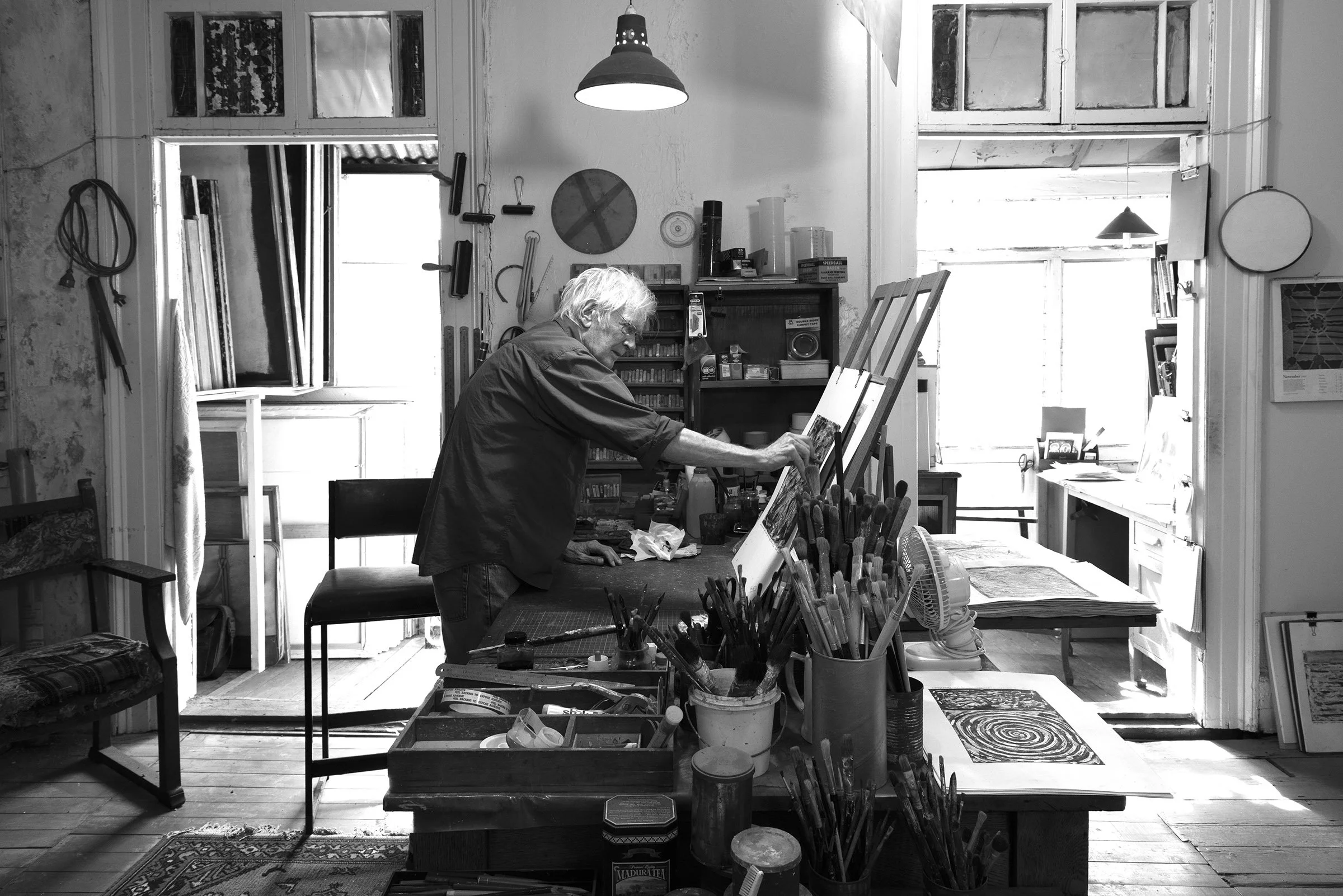Multidisciplinary artist Robert Eadie (1941–2025) practiced prolifically for over sixty years, working from the inner-city suburbs of Sydney and painting en plein air along the coastline of New South Wales, from Jervis Bay to the Pittwater.
Graduating from the National Art School in 1966, he went on to teach there for twenty years, and was appointed Head of Drawing and Painting in 1985. A fixture in Sydney’s art scene over this period, Eadie gained critical and commercial recognition for his portraiture, and large-scale colourist and abstract paintings.
Ever engaged with his broader community, Robert contributed his art and design skills to a range of social and political movements. He took part in the Artists for Parliamentary Democracy exhibition in 1975, participated in the Artists for Nuclear Disarmament project and TNT Tenants Group actions in 1979, contributed to the Woolloomooloo Green Bans murals in 1982, and advocated for the protection of the National Art School throughout the 1970s and 1980s.
Following a near-fatal stroke in 1989, Eadie’s practice transformed markedly. His later works—smaller in scale and softer in palette—embody both the limits of physical constraint and an amplified sensitivity to light and atmosphere.
Exhibiting widely, Eadie showed at the Biennale of Sydney, Sculpture by the Sea, the Melbourne Sculpture Triennial, the Manly Art Gallery & Museum, Artspace, Firstdraft, the Woollahra Gallery at Redleaf, and, on numerous occasions, as a finalist in the Archibald, Wynne and Sulman Prizes. His work is held in public and private collections including the Art Gallery of NSW and the National Art School.
Exhibition essay by Miriam McGarry, for ‘Strange Light’ held at Woollahra Gallery at Redleaf, August 2024
Drawing has been a reliable constant in Robert Eadie’s life. Growing up, the underside of his parents’ dining room table was transformed into a ‘child’s Sistine Chapel’, scrawled with towns and people. Through art school he developed his own style, and under the mentorship of dear friend and studio partner Rod Shaw, he learned to make sense of his work and find joy in his own practice. It was – and remains – a practice that finds space in the cracks around life’s demands. Working in little grabs, twenty minutes here and there, building hours in the studio across pockets of the day.
He emerged as part of the Sydney art scene, dabbling with fame and winning prizes as a colourist producing large-scale works, illuminated in the glow of a pack of bright young things. Robert used his art to share in causes he believed in, creating murals and posters alongside the anti-apartheid and anti-Vietnam movements. Working with the anti-development group, Green Bans, he painted an iconic large-scale mural of the Andrew (Boy) Charlton Pool on a railway pylon in Woolloomooloo. Then in 1989 Robert had a stroke. Everything turned upside down and a bewildering new world emerged. But while his life had changed, one thing remained. Robert reflects, ‘I had art, and I had family.’
Away from the art world, and temporarily confined to a wheelchair on the ground floor of his home, Robert’s world became smaller and more internally focused. ‘It had to’, he explains, ‘in order to survive.’ Note making and sketching in journals enabled a space for capturing thoughts, and to find vitality and fulfilment in his own inner world. His established way of working in snatches of time served him well as he regained strength, using moments to make marks with pastels on paper. Overtime he re-learnt to paint, paring the colour back to remove a complexity that challenged his brain after the stroke, but introducing a different kind of freedom to explore and ‘follow my nose.’
While the canvas size had to be adapted to suit Robert’s changed physicality, his ambition for resolved and potent work did not diminish. Robert retained his sense of creative attention and ability to capture a sense of form, light and depth in the land and seascapes around him. His works show the power of a breaking wave, a gash of blue sky breaking through the clouds, a dance of light through ghostly trees. Weighty depths and solid forms are balanced with fleeting light or movement offering both stability, and moments of freedom and expansiveness. Robert explains that he ‘learnt to make something of substance out of what had previously been a sketch. And [he] also learnt that smaller works could be joined together to make something larger.’
Here he is referring to the collection of works installed as a gridded series to create one cohesive seascape of bobbing cardinal marks in Harbour Marks (1993-2003). But the comment also captures his practice and life more broadly. Putting on Bach or old country music in the studio, making a cup of tea, watching the ocean, a note or sketch in a journal, taking a walk, drawing, drawing, drawing. Making a meaningful life and artistic practice out of the smaller pieces joined together.
And now Strange Light shares some of those small pieces, joined together to capture the harbour's shifting moods, the last rays of light across the water, a detritus of shopping trolleys and the rhythm of living. This exhibition illuminates Robert’s lifelong commitment to art making as a way of being in the world. As friend Kevin Connor described, when discussing his Archibald Prize finalist portrait of Robert, ‘He’s somebody I’ve always admired. What you’d call an artist’s artist. He’s also an extremely quiet man who doesn’t seek the limelight, a gentle character.’
Strange Light depicts a body work made outside of the limelight, created with humble integrity and artistic excellence. The exhibition also reflects what became most important to Robert after the stroke: ‘family, working, and going for walks.’
